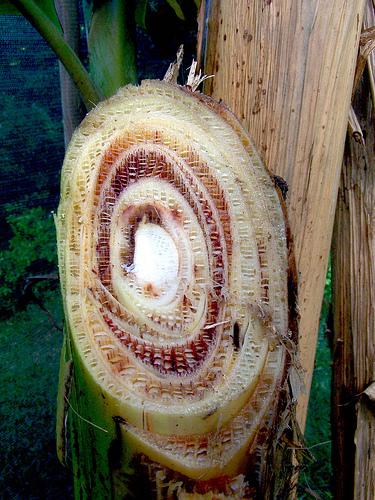Panama Disease in Bananas
Background
Panama disease is a fungal borne pathogen first reported on an Australian banana farm in 1876 [1]. The disease causes fusarium wilt in banana plants, ultimately leading the death of the crop. Panama disease is caused by the fungal pathogen Fusarium oxysporum, of the Ascomycota phylum. There are different strains, or "races", of the fungus known to infect specific types of banana plants [1]. The disease has been responsible for two worldwide die-offs of banana plants, the second of which is ongoing. These epidemics have been responsible for the loss of hundreds of thousands of hectares of plantation land area and millions of dollars worth of dead crops [1,7,10]. To date, there is not a fungicide or other method known to be effective in combatting F. oxysporum [1]. The disease is subject to a large amount of current agricultural research in an attempt to deter or stop the further spread of the disease to non-infected areas, as well as devising a genetic resistance to the pathogen [1-11]. As of 2017, Panama disease infected Cavendish banana plants have been reported in East Africa, Asia, the Middle East, and Australia [4]. Without significant progress in effective treatments for the disease, the pathogen is expected to continue to cause further economic and agricultural damage to the banana industry as well as endanger the Cavendish banana variety as a world food staple [2,4].
History
Figure 1. A plate showing F. oxysporum growth. [18]Panama disease was first reported in Australia in 1876. However, the widespread appearance of the fusarium wilt was first noted in Panama, thus giving the disease its name [1]. At this time, the dominant dessert banana variety was the "Gros Michel". Widely cultivated in the Americas, Asia, Australia and Africa, the "Gros Michel' was ubiquitous in the banana industry [1]. Throughout the first half of the 20th century, large scale epidemics occurred throughout the Banana growing agricultural region located on either side of the equator [7]. The recognition that F. oxysporum was the microbial cause of the fusarium wilt in banana plants occurred in 1910 [1]. By the halfway point of the 20th century, the disease had rendered a vast amount of banana plantation acreage unusable. Plantations were abandoned, other fruits were instead cultivated, or new lands were planted that were still considered to be free of the fungus [1]. The advent of large scale agricultural transportation via trains, cargo ships, and paved roadways aided in the spread of the disease to previously non-infected areas [1]. The 1950s brought about the near collapse of the commercial dessert banana industry. However, at this time a different variety of bananas, known as the Cavendish variety, were discovered to be growable on plantations previously devastated by the disease. The United Fruit Company, which recently had devoted a large amount of research funds to limiting the spread of the disease, scaled back such efforts with the emergence of the Cavendish as a viable alternative [1]. The Cavendish is more fragile to environmental stressors, and to damage from transport, as compared to the 'Gros Michel' [4]. Additionally, the Cavendish banana was seen as less sweet, and therefor less desirable in Western markets. However, selective breeding gave the Cavendish the distinctive flavor it is currently known for [4]. Cavendish bananas rapidly became the dominant variety cultivated due to the perception that the variety was entirely resistant to F. oxysporum infection. Contrary to this belief, Cavendish bananas were already being infected by a different strain of the fungus in the 1960s in Taiwan. This new strain, known as Tropical Race 4 (TR4), has caused the demise of banana plantations throughout Southeast Asia and China [1]. It has additionally been reported in the Australian province of Queensland since the beginning of the 2000s. Today, nearly all exported dessert bananas are of the Cavendish variety. Panama disease has not been reported on Cavendish plantations in Latin America at this point in time [14].
Section 2
Include some current research, with at least one figure showing data.
Section 3
Include some current research, with at least one figure showing data.
Section 4
Conclusion
References
[1]
Ordonez, N., Seidl, M.F., Waalwijk, C., André, D., Kilian, A., Thomma, B.P.H., Ploetz, R.C., Kema, G.H.J. "Worse Comes to Worst: Bananas and Panama Disease- When Plant and Pathogen Clones Meet." PLOS Pathogens. 2015. Volume 11(11). p. 1-7.
Authored for BIOL 238 Microbiology, taught by Joan Slonczewski, 2017, Kenyon College.

